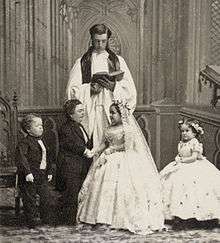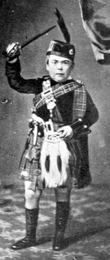General Tom Thumb
| General Tom Thumb | |
|---|---|
 Charles Sherwood Stratton and Lavinia Warren wedding photo. From left to right: George Washington Morrison Nutt (1844–81), Charles Sherwood Stratton (1838–83), Lavinia Warren Stratton (1842–1919), Minnie Warren (1849–78). | |
| Born |
Charles Sherwood Stratton January 4, 1838 Bridgeport, Connecticut United States |
| Died |
July 15, 1883 (aged 45) Bridgeport, Connecticut United States |
| Cause of death | Stroke |
| Resting place |
Mountain Grove Cemetery, Bridgeport, Connecticut United States 41°10′19″N 73°13′29″W / 41.17189°N 73.22465°W |
| Nationality | United States |
| Known for |
Celebrity Circus performer |
| Height | 99 cm (3.25 ft) |
| Weight | 32 kg (71 lb) |
| Spouse(s) | Lavinia Warren (m.1863 - 1883) |
Charles Sherwood Stratton (January 4, 1838 – July 15, 1883), better known by his stage name "General Tom Thumb", was a dwarf who achieved great fame as a performer under circus pioneer P.T. Barnum.[1]
Childhood and early life

Stratton was the son of a Bridgeport, Connecticut, carpenter named Sherwood Edward Stratton, son of Seth Sherwood Stratton and Amy Sharpe. Sherwood married his first cousin Cynthia Thompson, daughter of Joseph Thompson and Mary Ann Sharpe. Charles Stratton's maternal and paternal grandmothers, Amy and Mary Ann Sharpe, were stated to be small twin girls born on July 11, 1781/83 in Oxford, New Haven, Connecticut.
Born in Bridgeport to parents who were of medium height, Charles was a relatively large baby, weighing 9 pounds 8 ounces (4.3 kg) at birth.[2] He developed and grew normally for the first six months of his life, at which point he was 25 inches (64 cm) tall and weighed 15 pounds (6.8 kg). Then he suddenly stopped growing. His parents became concerned when, after his first birthday, they noticed he had not grown at all in the previous six months. They showed him to their doctor, who said there was little chance Charles would ever reach normal height.
By late 1842 (4 years old), Stratton grew only one inch from when he was six months old. Apart from this, he was a totally normal, healthy child, with several siblings who were of average size.
Adoption by Barnum

Phineas T. Barnum, a distant relative (half fifth cousin, twice removed[3]), heard about Stratton and after contacting his parents, taught the boy how to sing, dance, mime, and impersonate famous people. Barnum also went into business with Stratton's father, who died in 1855. Stratton made his first tour of America at the age of five, with routines that included impersonating characters such as Cupid and Napoleon Bonaparte as well as singing, dancing and comical banter with another performer who acted as a straight man. It was a huge success and the tour expanded.
A year later, Barnum took young Stratton on a tour of Europe, making him an international celebrity.[4] Stratton appeared twice before Victoria of the United Kingdom of Great Britain and Ireland. He also met the three-year-old Prince of Wales, who would become King Edward VII. In 1845, he triumphed at the Théâtre du Vaudeville (France) in the play Le petit Poucet of Dumanoir and Clairville. The tour was a huge success, with crowds mobbing him wherever he went. After his three-year tour in Europe, Stratton began his rise to stardom in the United States. Stratton’s fame grew at an astonishing rate, and his popularity and celebrity surpassed that of any actor within his lifetime.[5]
On his return home from his second tour in 1847, aboard the SS Cambria, he attracted the attention of the explorer John Palliser who "was not a little surprised, on entering the state-cabin, to hear the most unnatural shrill little pipe exclaiming, “Waiter! bring me a Welsh rabbit”.[6] During the voyage, General Tom Thumb contributed to a collection for the relief of famine victims in Ireland.[7]
Stratton’s first performances in New York marked a turning point in the history of freak show entertainment. Prior to Stratton’s debut, the presentation of ‘human curiosities’ for the purpose of entertainment was deemed dishonorable and seen as an unpleasing carnival attraction. However, after viewers were introduced to Stratton and performances, he was able to change the perception people held toward freak shows. Stratton’s lively and entertaining performances made these types of carnival shows one of the most favored forms of theatrical entertainment in the United States.[5]
From the age of seven, Stratton performed in grand full-length fairytale melodramas under the management of P.T. Barnum. A few of the melodramas that Stratton performed were “Hop O’ My Thumb” and the “Seven League Boots”. In these melodramas, Stratton was assigned the title role, which he played on multiple occasions. While Barnum sought to capitalize on Stratton’s small stature, he also aimed to highlight and showcase his many true gifts as a performer. For example, Stratton was noted to be clever in his acts. In addition, he was a talented actor, singer, dancer and comedian. As a result, certain dramatic critics did not focus on comparing his skills to those of the freak show community of which he was a member. Instead, critics judged him on his merits as a professional entertainer.[5]
In 1846 he started to grow for the first time since the first few months of his life, but extremely slowly. In January 1851 Stratton stood exactly 2 feet 5 inches (74 cm) tall. On his 18th birthday, he was measured at 2 feet 8.5 inches (82.6 cm) tall. On his 21st birthday he was 86 cm tall. Stratton became a Freemason on October 3, 1862. Stratton, by now 2 feet 11 inches (89 cm) tall, was initiated to be a Freemason alongside a man who was 6 feet 3 inches (191 cm).[8]
Marriage and later life

His marriage in 1863 to a little person, Lavinia Warren, became front-page news. The wedding took place at Grace Episcopal Church, and the wedding reception was held at New York City's Metropolitan Hotel. The couple stood atop a grand piano at the reception to greet some 10,000 guests. The best man at the wedding was George Washington Morrison ("Commodore") Nutt, another dwarf performer in Barnum's employ. The maid of honor was Minnie Warren, Lavinia's sister. Following the wedding, the couple was received by President Lincoln at the White House. Stratton and his wife toured together in Europe as well as British India, in particular the area that would later become Bangladesh.
Under Barnum's management, Stratton became a wealthy man. He owned a house in the fashionable part of New York and a steam yacht, and he had a wardrobe of fine clothes. He also owned a specially adapted home on one of Connecticut's Thimble Islands. When Barnum got into financial difficulty, Stratton bailed him out. Later, they became business partners. Stratton made his final appearance in England in 1878.
On January 10, 1883, Stratton was staying at John F. Antisdel's Newhall House in Milwaukee when a fire broke out, which Milwaukee historian John Gurda would call "one of the worst hotel fires in American history". More than 71 people died, but Tom and Lavinia were saved by their manager, Sylvester Bleeker.[9]
Death and legacy
Six months after surviving the Newhall House fire, Stratton died unexpectedly of a stroke. He was 45 years old. Over 20,000 people attended the funeral. P. T. Barnum purchased a life-sized statue of Tom Thumb and placed it as a grave stone at Mountain Grove Cemetery in Bridgeport, Connecticut.[10] When she died more than 35 years later, Lavinia Warren was interred next to him with a simple grave stone that read: "His Wife".
In 1959, vandals smashed the statue of Tom Thumb. It was restored by the Barnum Festival Society and Mountain Grove Cemetery Association with funds raised by public subscription.[11]
The cause of Stratton's extreme shortness is still unknown. X-rays were not discovered until 1895, 12 years after Stratton's death, and the medical techniques of the day were unable to ascertain the pathology underlying his diminutive size.
Sam Humphrey portrayed General Tom Thumb in the 2017 musical film, The Greatest Showman.
See also
- Stamford Museum where a suit of his clothes is displayed for comparison with those of Daniel Lambert.
- Tom Thumb House (Middleborough, Massachusetts), his summer house.
- Middleborough Historical Museum, which exhibits a large collection of Tom Thumb memorabilia.
References
- ↑ Hawkins, Kathleen (November 25, 2014). "The real Tom Thumb: History's smallest superstar" – via www.bbc.co.uk.
- ↑ Thumb, Tom (1874). Sketch of the life: personal appearance, character and manners of Charles S. Stratton, the man in miniature, known as General Tom Thumb, and his wife, Lavinia Warren Stratton, including the history of their courtship and marriage ... Also, songs given at their public levees. S. Booth. p. 4. Retrieved March 5, 2011.
- ↑ Notable Kin, Gary Boyd Roberts, 1999.
- ↑ "Page 1 Passport Applications, 1795-1905 - Fold3".
- 1 2 3 Chemers, Michael M. (2004). "Jumpin' Tom Thumb: Charles Stratton Onstage at the American Museum". Nineteenth Century Theatre and Film. 31 (2): 16–27. doi:10.7227/nctf.31.2.3.
- ↑ Palliser, John. 1853. Solitary Rambles and Adventures of a Hunter in the Prairies, John Murray, London, 326 p.
- ↑ Christine Kinealy, 'Charity and the Great Hunger. The kindness of Strangers' (London: Bloomsbury, 2013).
- ↑ 10,000 Famous Freemasons, William R. Denslow. Missouri Lodge of Research, Trenton, Missouri:1957–1961, vol 4. p. 200.
- ↑ P.T. Barnum: America's Greatest Showman, Kunhardt, Philip B., Jr., Kunhardt, Philip B., III and Kunhardt, Peter W., Alfred A.Knopf, 1995. ISBN 0-679-43574-3.
- ↑ "Charles Sherwood "General Tom Thumb" Stratton". Find a Grave. Retrieved November 1, 2010.
- ↑ Marker on the side of Tom Thumb's grave marker. The Historical Marker Database – accessed February 11, 2010
Further reading
- Lehman, Eric D. Becoming Tom Thumb: Charles Stratton, P.T. Barnum, and the Dawn of American Celebrity (Wesleyan University Press, distributed by University Press of New England; 2013) 276 pages; scholarly biography
- American Sideshow: An Encyclopedia of History's Most Wondrous and Curiously Strange Performers (Tarcher/Penguin 2005), by Marc Hartzman.
External links
| Wikimedia Commons has media related to Charles Sherwood Stratton. |
- "Sideshow Ephemera Gallery: General Tom Thumb" by James G. Mundie – biographical essay with photos
- Harper's portrait and report on General Tom Thumb's Wedding
- Details of a museum in Middleboro, MA. A town where they made their home. – Link points to RoadsideAmerica.com
- "Tom Thumb" at the Disability History Museum
- The South Dakota Music Museum where a violin given to him, purported by P.T. Barnum to be a Stradivarius, rests in the Everist Gallery.
- "Tom Thumb". Theatre and Performance. Victoria and Albert Museum. Retrieved February 15, 2011.